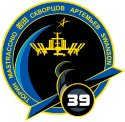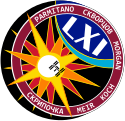Alexander Alexandrowitsch Skworzow
| Alexander Skworzow | |
|---|---|
 | |
| Land | Russland |
| Organisation | Roskosmos |
| Rufzeichen | Утёс („Felsen“)[1] |
| ausgewählt | 28. Juli 1997 |
| Einsätze | 3 Raumflüge |
| Start des ersten Raumflugs | 2. April 2010 |
| Landung des letzten Raumflugs | 6. Februar 2020 |
| Zeit im Weltraum | 545d 23h 08min |
| EVA-Einsätze | 2 |
| EVA-Gesamtdauer | 12h 34min |
| ausgeschieden | 29. April 2022 |
| Raumflüge | |
Alexander Alexandrowitsch Skworzow (russisch Александр Александрович Скворцов; * 6. Mai 1966 in Schtscholkowo, Oblast Moskau, UdSSR) ist ein ehemaliger russischer Kosmonaut. Er ist der Sohn des 1968 ohne Mission ausgeschiedenen Kosmonauten Alexander Alexandrowitsch Skworzow.
Ausbildung
1987 absolvierte er die Luftwaffen-Ingenieurhochschule in Stawropol. 1997 machte er seinen Abschluss an der Akademie der Luftverteidigungskräfte,[2] Mitte 2012 schied er als Oberst der russischen Luftwaffe aus dem aktiven Dienst aus.[3]
Kosmonautentätigkeit
Am 28. Juli 1997 wurde Skworzow als Kosmonaut ausgewählt, seine Kosmonauten-Grundausbildung schloss er im November 1999 ab.
Skworzow war der Ersatzmann für Maxim Surajew während dessen Flug als Kommandant der Mission Sojus TMA-16 zur Internationalen Raumstation (ISS).
Skworzow war Bordingenieur der ISS-Expedition 23 und Kommandant der ISS-Expedition 24. Der Start mit dem Raumschiff Sojus TMA-18 zur ISS fand am 2. April 2010 statt.[4] Die Landung erfolgte am 25. September 2010 in Kasachstan.[5]
Skworzow arbeitete als Bordingenieur für die ISS-Expeditionen 39 und 40. Das Raumschiff Sojus TMA-12M startete am 25. März 2014, die Kopplung konnte wegen Problemen mit der Raumschiffsteuerung nicht wie vorgesehen nach knapp sechs Stunden durchgeführt werden, sondern erfolgte erst zwei Tage später am 27. März. Fast ein halbes Jahr war der russische Kosmonaut Alexander Skworzow auf der Internationalen Raumstation ISS. Am 11. September 2014 landete er wieder wohlbehalten auf der Erde.[6] Im Februar 2016 wurde er mit dem Verdienstorden für das Vaterland 4. Klasse ausgezeichnet.[7]
Für seinen dritten Raumflug war Skworzow ursprünglich als Kommandant des Raumschiffes Sojus MS-07 vorgesehen. Im März 2017 wurde bekannt, dass er auf Grund eines Sportunfalls vom vorbereitenden Training zurückgezogen und durch Anton Schkaplerow ersetzt wurde.[8] Am 20. Juli 2019 startete er als Kommandant von Sojus MS-13 zur ISS. Zusammen mit Luca Parmitano und Andrew Morgan war er Mitglied der ISS-Expeditionen 60 und 61.[9] Am 6. Februar 2020, 09:12 (UTC) landete Sojus MS-13 in Schesqasghan, Kasachstan.
Am 29. April 2022 schied Skworzow aus dem russischen Kosmonautenkorps aus.[3] Mit 545 Tagen im All gehört er zu den erfahrensten Raumfahrern der Welt.[10]
Siehe auch
Weblinks
- Biografie von Alexander Alexandrowitsch Skworzow in der Encyclopedia Astronautica (englisch)
- Biografie von Alexander Alexandrowitsch Skworzow beim Juri-Gagarin-Kosmonautentrainingszentrum (russisch)
- Kurzbiografie von Alexander Alexandrowitsch Skworzow bei spacefacts.de
Einzelnachweise
- ↑ Позывные экипажей советских/российских космических кораблей. astronaut.ru, 31. Oktober 2010, abgerufen am 21. November 2010 (russisch).
- ↑ Cosmonaut Bio: Alexander Alexandrovich Skvortsov. NASA, Juni 2010, archiviert vom Original am 4. März 2016; abgerufen am 4. März 2014 (englisch).
- ↑ a b Kosmonautenbiographie: Alexander Skworzow Jr. spacefacts.de, 29. April 2020, abgerufen am 30. April 2022.
- ↑ Günther Glatzel: Sojus-TMA 18 unterwegs zur ISS. raumfahrer.net, 2. April 2010, abgerufen am 4. März 2014.
- ↑ Thomas Weyrauch: Besatzung von Sojus-TMA 18 gelandet. raumfahrer.net, 25. September 2010, abgerufen am 4. März 2014.
- ↑ Günther Glatzel: Sojus-TMA 12M an ISS gekoppelt. raumfahrer.net, 28. März 2014, abgerufen am 28. März 2014.
- ↑ Erlass des Präsidenten der Russischen Föderation vom 15.02.2016 N 59 „Über die Auszeichnung mit den staatlichen Auszeichnungen der Russischen Föderation“ (russisch)
- ↑ О космонавтах и астронавтах. Новости космонавтики, abgerufen am 12. Dezember 2017 (russisch).
- ↑ Экипажи на подготовке. Центр подготовки космонавтов имени Ю. А. Гагарина, abgerufen am 19. Mai 2018 (russisch).
- ↑ Astronauten und Kosmonauten (geordnet nach "Gesamtflugzeit"). spacefacts.de, 29. April 2022, abgerufen am 30. April 2022.
| Personendaten | |
|---|---|
| NAME | Skworzow, Alexander Alexandrowitsch |
| ALTERNATIVNAMEN | Скворцов, Александр Александрович (russisch) |
| KURZBESCHREIBUNG | russischer Kosmonaut |
| GEBURTSDATUM | 6. Mai 1966 |
| GEBURTSORT | Schtscholkowo, Oblast Moskau, UdSSR |
Auf dieser Seite verwendete Medien
Der Brennpunkt des Expedition-23-Emblems illustriert den wunderschönen Planeten Erde in der schwarzen Weite des Alls. Die Bahn der Internationalen Raumstation (ISS) im Orbit fliegt durch die XXIII um zu zeigen, dass dieser Zugewinn auf den vorherigen Missionen aufbaut und die Grundlage für zukünftige Missionen ist. Dies zeigt die Arbeit an Bord des Orbitalkomplexes, die letztendlich den Weg zu Missionen zum Mond, Mars und darüber hinaus ebnen wird. Die Missionsbezeichnung benutzt römische Ziffern um die Heimatnationen der Crew zu zeigen, die durch ihre Nationalflaggen repräsentiert werden. Die zwei Sterne symbolisieren die zwei Teams, die diese Expeditionscrew ausmachen.
ISS Expedition 39 Patch
Increment 39 of the International Space Station Program marks the 15th year of operation since the start of the space laboratory assembly. Today, the U.S., Russia, Japan, Canada and the European Space Agency are partnering in the operation of the largest ever orbital outpost managed by humankind. The names of the six crew members are depicted in their native languages. For Expedition 39, the Soyuz spacecraft serves as transport vehicle for the crew members to and from the station. During this expedition, the ISS will serve as a platform for scientific research, Earth and astronomical observation, education, as well as a stage for the development of new technologies used for the exploration beyond low Earth orbit. The star above the complex signifies human space exploration towards new frontiers. The crew members added these words: "The crew of Expedition 39 is proud to serve the international community in furthering our scientific knowledge and in expanding human presence in space."
The Expedition 40 patch depicts the past, present, and future of human space exploration. The crew wrote the description that follows: The reliable and proven Soyuz, our ride to the International Space Station (ISS), is a part of the past, present, and future. The ISS is the culmination of an enormous effort by many countries partnering to produce a first-class orbiting laboratory, and its image represents the current state of space exploration. The ISS is immensely significant to us as our home away from home and our oasis in the sky. The commercial cargo vehicle is also part of the current human space exploration and is a link to the future. A blend of legacy and future technologies is being used to create the next spacecrafts which will carry humans from our planet to destinations beyond. The sun on Earth's horizon represents the new achievements and technologies that will come about due to our continued effort in space exploration.
The Expedition 60 crew insignia
- The Moon landing is one of the most extraordinary feats of humankind, an embodiment of ingenuity and desire for exploration. The patch of Expedition 60 commemorates the 50th anniversary of that landing: a constellation of three stars with the Moon superimposed forms the letter “L,” the Latin symbol for 50. The Moon is depicted as a waxing crescent, as it was on July 20, 1969.
- The familiar silhouette of the International Space Station is visible, flying across the night sky. Stars, numerous and bright as seen from the space station, form the shape of an eagle in the same pose as on the iconic patch of the Apollo 11 mission. The sunrise represents the fact that we are still in the early stages of humanity’s exploration of space.
- The hexagonal shape of the patch represents the space station's cupola, with the six points of the hexagon symbolizing the six crewmembers of Expedition 60. The names and nationalities are not present, as on the original Apollo 11 mission patch, to highlight that space missions – then, now, and in the future – are for Earth and all humankind.
Alexander Skvortsov, Expedition 23 flight engineer
The mission insignia for the Expedition 61 crew with Commander Luca Parmitano of ESA (European Space Agency), NASA astronauts Drew Morgan, Christina Koch and Jessica Meir and Roscosmos cosmonauts Alexander Skvortsov and Oleg Skripochka.
- The Expedition 61 patch represents an exciting and dynamic time aboard the International Space Station as it constantly advances towards a limitless future in space. The overall patch view is from an approaching vehicle in pursuit of the space station. The sun is the most prominent, central element in the patch as the source of energy and life for the Earth, the station and our entire solar system. As the present focus of human spaceflight, the space station is centered in the emblem while barely eclipsing the sun with its tiny shadow, reminding of us that human exploration is a small part of our quest to understand the universe.
- Fifteen of the sun’s rays represent the 15 original partner members of the space station program, while the 16th ray represents an open invitation for continued collaboration with new partners. The four yellow rays form the cardinal directions of a compass, symbolizing the innate human drive to explore. The advancing terminator represents the dawn of a new day on Earth. The name ring appears to float through space and has no single orientation, emphasizing the variety of viewpoints assembled in an international crew unified under one mission. Nine rays extend beyond the name ring to represent the nine human missions that have braved exploration beyond low-Earth orbit, thus encouraging us to drive boundlessly out into our solar system.
The official crew patch for Expedition 24, the 24th long-duration mission to the International Space Station.
- Science and Exploration are the cornerstones of NASA's mission onboard the International Space Station (ISS). This emblem signifies the dawn of a new era in our program's history. With each new expedition, as we approach assembly complete, our focus shifts toward the research nature of this world-class facility. Prominently placed in the foreground, the ISS silhouette leads the horizon. Each ray of the sun represents the five international partner organizations that encompass this cooperative program. Expedition 24 is one of the first missions expanding to a crew of six. These crews, symbolized here as stars arranged in two groups of three, will launch on Soyuz vehicles. The unbroken flight track symbolizes our continuous human presence in space, representing all who have and will dedicate themselves as crew and citizens of the International Space Station.






